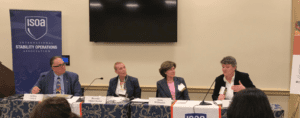When women are involved in negotiations, we all win
With the U.S. currently embroiled in multiple conflicts around the world, costing lives and diverting resources, what if there was a way to make peace agreements more effective? Evidence shows that when women are involved in peace negotiations, it’s 35% more likely that the resulting peace agreement will last 15 years or more. Women also tend to broaden peace and reconciliation agendas to include topics like services and reparations for victims and the reintegration of ex-combatants into society.

“The issue is getting more women to the table and part of formal negotiation teams,” said Bronwen Morrison, Senior Director of the Center for Global Security and Stabilization at Dexis, at the Women in Stabilization Forum on Capitol Hill organized by the International Stability Operations Association (ISOA).
Through the much-anticipated Women, Peace, and Security Act of 2017, and the follow-on June release of the White House 2019 Women, Peace, and Security Strategy, the U.S. government has codified its commitment to increasing the role of women in peacebuilding and security into law.
This includes legal requirements for reporting to Congress on implementing provisions of the Act. U.S. agencies, such as the Department of Defense (DoD), Department of State, and USAID, must train personnel on the needs and perspectives of women in preventing, mediating, and resolving conflict, make concrete financial commitments towards implementation, and provide needed metrics on implementation and progress.
Another speaker at the Forum, Anne Witkosky, former Deputy Assistant Secretary of Defense for Stability and Humanitarian Affairs, praised the Act as “the most comprehensive in the world,” and emphasized its bipartisan support in Congress.
“The genesis came out of Beijing,” says Bronwen, referencing the Women, Peace, and Security Act’s roots in the Fourth World Conference on Women in 1995. During the watershed event, the issue of women and armed conflict was identified as one of the 12 critical areas of concern in the Beijing Platform for Action.
This was a powerful influencer on the groundbreaking UN Security Council Resolution 1325 (UNSCR 1325) on Women, Peace, and Security, which stresses the important role women play in conflict prevention and resolution. Since 1325 passed in 2000, it has, “…led to the deployment of gender advisers in peacekeeping operations and at [UN] headquarters, the development of a gender resource package and training materials,” and the inclusion of “gender issues in both thematic and mission-specific reports.”
This in turn contributed to the development of the U.S. National Action Plan (NAP) on Women, Peace, and Security in 2011. Created by a broad network of various government agencies and civil society representatives, the NAP bolstered the integration of women’s views, perspectives, and presence into and across U.S. peacebuilding and security efforts.
Now there are 79 National Action Plans around the world, including 11 regional plans. These serve as mandates for countries to ensure women’s meaningful participation. It is important to note, however, that only 43% of these efforts have been fully funded to date.
Bronwen and other speakers listed some of the areas where these efforts have led to significant progress in integrating women into peacebuilding around the world:
- India has contributed all-female battalions to UN peacekeeping missions since 2007;
- Women’s participation in Colombia’s peace accord in 2016 led to the inclusion of over 100 gender provisions; and
- Women have been successfully deployed in UN peacekeeping operations in Somalia.
Noting these global achievements, Bronwen said, “We need to do work not just on the partner country side but on the U.S. side.”
Metrics are simply lacking. Among the various U.S. agencies, USAID has led the way in measuring its progress. But now per the White House Women, Peace, and Security Strategy, U.S. DoD, USAID, and U.S. Department of State must present metrics and financial commitments related to the Women, Peace, and Security Act to Congress by October 2019. This reporting has the potential to share learning and increase accountability and thereby encourage more action at the agency level.
We know that peacebuilding is more effective when women are directly involved. The meaningful participation of women is essential not only to achieve stability but to maintain it. And with the Women, Peace, and Security Act and White House Strategy, the U.S. has an ideal platform to expand on its earlier commitments to consciously engage women in stabilization and security efforts. As U.S. Congressman Rob Wittman stated during the Forum, “Women need to lead the way.”


